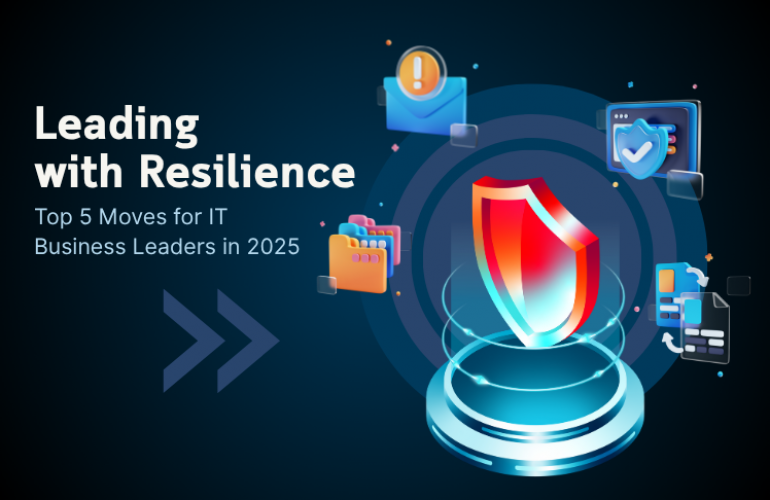
Strategies every IT leader should prioritize now
With every passing year, technology evolves and so does cyber risk—2025 is no exception. In fact, the stakes have never been higher. AI-driven threats are becoming faster and harder to detect, while hybrid work environments and expanding digital footprints continue to stretch security teams thin.
What sets this year apart isn’t just the volume of attacks, but the speed, precision, and unpredictability with which they strike. For IT and business leaders, one thing is clear: building true cyber resilience isn’t optional—it’s urgent.
Cyberattacks are increasing at an estimated rate of 20–30% each year. (Cobalt)
As the threat landscape expands, organizations must proactively evolve their defenses—not just react when it’s too late.
Here are the top moves every IT and business leader should make to prepare their organization for the evolving threat landscape:
Treat Cybersecurity Like a Business Problem
Cybersecurity doesn’t live in a silo. Security gaps, downtime, and data breaches can all lead to major business disruption. That’s why leaders need to frame cybersecurity through a business lens—connecting risk to cost, continuity, compliance, and reputation.
A clear business-aligned approach helps:
- Justify security investments
- Foster executive buy-in
- Align teams across IT, operations, and leadership
Start by recognizing that security isn’t the responsibility of a single department—it’s a mindset the entire organization must adopt. Consider implementing regular security awareness training to help staff recognize threats and understand their role in keeping the organization secure.
Get Proactive with Penetration Testing and Tabletop Exercises
Being prepared means stress testing both your systems—and your team.
Penetration testing simulates real-world attacks to uncover technical vulnerabilities, while tabletop exercises walk leadership through incident scenarios to evaluate response, communication, and escalation protocols. Together, these simulations reveal both system gaps and process flaws that could hinder your ability to respond in real time.
These exercises are not “one-and-done” events. As your environment evolves, so do your risks—and attackers adapt just as fast. Making these exercises a regular part of your cybersecurity strategy ensures your team stays sharp, your defenses stay relevant, and your business stays resilient.
Organizations that suffer a breach are 6x more likely to face prolonged downtime in the six months that follow.
Running simulations before an attack strikes can be the difference between rapid containment—and costly disruption.
Take a Risk-Based Approach to Cybersecurity
Not all threats carry equal weight. A Risk-Based Approach helps you prioritize security investments where they matter most—aligned with your organization’s operational and compliance needs.
Rather than chasing every alert, you focus on vulnerabilities with the greatest potential impact.
Organizations that adopt a risk-based cybersecurity model can reduce breach-related costs by up to 40%. The right focus not only improves protection—it also improves ROI.
Strengthen Identity and Access Management
With hybrid workforces and third-party integrations more common than ever, Identity and Access Management (IAM) is a foundational pillar of cyber resilience.
This includes implementing MFA, zero-trust principles, and regularly reviewing access rights to ensure only the right users have the right level of access at the right time.
Embrace a Framework-Based Risk Assessment
Cybersecurity is more than ticking boxes—it’s about understanding where you are and where you need to be.
A structured risk assessment—like IMP’s Cybersecurity Health Check—can help.
It evaluates your organization against the CIS Top 18 Controls. It identifies current-state maturity, highlights gaps, and provides a prioritized roadmap to improve your overall security posture.
With a clear security scorecard in hand, leaders can:
- Visualize maturity across each control
- Communicate risk to stakeholders
- Plan strategic improvements
Build an Incident Response Plan (And Keep It Updated)
When—not if—a security incident occurs, a documented, tested incident response (IR) plan is critical. IR plans define:
- Key roles and responsibilities
- Steps for containment, investigation, and recovery
- Communication procedures (internal and external)
Too often, organizations either don’t have a plan or haven’t revisited it in years. Your plan should be a living document, reviewed and updated regularly to reflect evolving threats, business changes, and lessons learned from past events.
The Takeaway
Cyber resilience isn’t just about having tools—it’s about having the right strategy, leadership, and accountability across your organization – and now is the time to make this a business priority.
Ready to see where your organization stands?
Request a Cybersecurity Health Check from IMP. We’ll evaluate your maturity against the CIS Controls and provide a customized scorecard and roadmap to help you reduce risk and improve resilience.
Interested in a Health Check?
Reach out to Senior Network Engineer Dan Parr at Dan.Parr@IMPSolutions.com for more information.